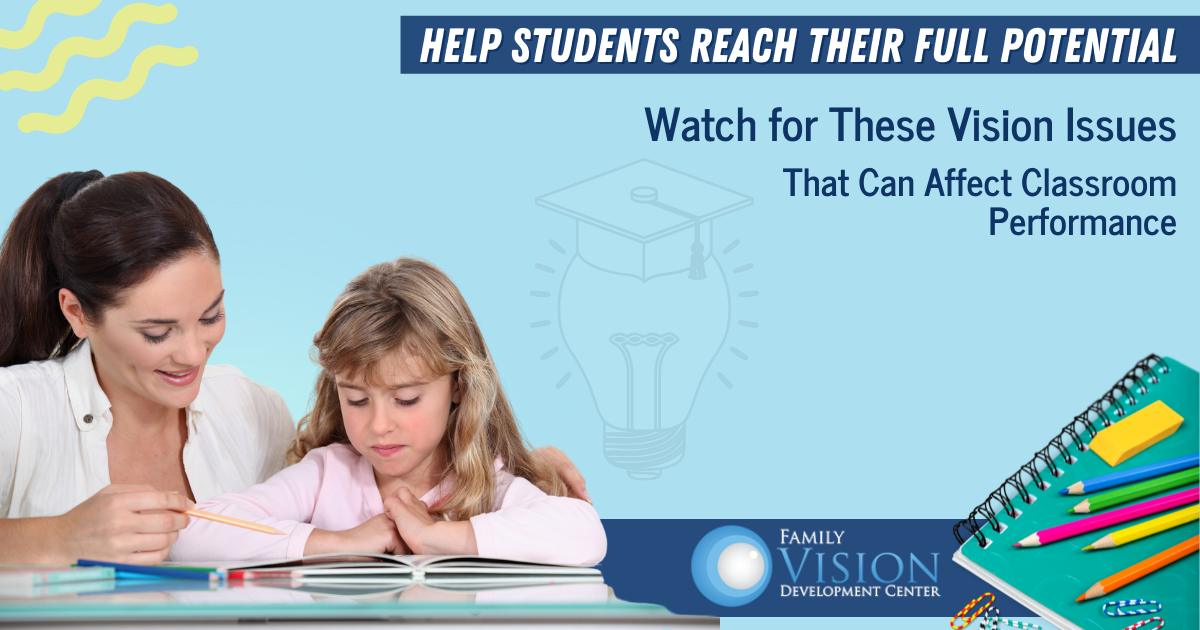Teachers spend so much time interacting with their students on a daily basis, which gives them a great opportunity to notice a student’s possible vision problems. Classroom activities can reveal that a child is struggling to keep up. And in many cases, those learning difficulties could be due to an undiagnosed vision issue. Detecting problems early on can allow for quicker, more efficient treatment. Therefore, teachers that notice any of the following symptoms in their students should notify a parent or guardian right away.
Amblyopia
Amblyopia, also called “lazy eye”, is a common vision condition in children. This disorder occurs when the eyes and brain do not work together properly. As a result, the brain will choose to use only one eye as its primary source of visual information. The other eye will “shut off” and will not be used very often, or at all. Usually this results in one eye not being able to see 20/20. Sometimes this will cause the eye to drift in or out, but many times it remains perfectly straight. Other than physical appearance, teachers can also look for signs of amblyopia which could include messy handwriting, poor eye-hand coordination, poor depth perception such as excessive tripping or running into doors and difficulty reading.
Strabismus
This is another type of common vision disorder that results from the brain having difficulty using both eyes at the same time. If the stress of using both eyes together becomes too challenging, the brain will often allow one of the eyes to turn out or turn in to remove the problem, since using one is less confusing. This differs from Amblyopia in that both eyes have the ability to see 20/20 but not at the same time. Symptoms for strabismus can also include double vision, headaches, eye strain, eye fatigue, squinting, closing or covering one eye to look at objects, poor depth perception, balance and coordination issues, poor sports performance or difficulty reading or concentrating. As you can see, there is a lot of overlap of symptoms with these types of vision issues. Only a proper binocular vision evaluation can delineate the difference.
Accommodative Disorder
This type of disorder affects a child’s ability to focus their eyes properly. This happens particularly at near distances or when switching focus from near to far away. When this vision disorder is present, a child may struggle with blurred vision, eye strain and fatigue, eye discomfort or headaches. Teachers might notice a child having difficulty with reading, writing or computer work, or focusing on the front of the classroom after working at their desk. Additionally, they could notice a student rubbing their eyes a lot or excessively blinking their eyes. Any of these symptoms can indicate an accommodative disorder.
Convergence Insufficiency
This condition is characterized by the inability to move and focus both eyes inward on near objects comfortably. A child would often notice the symptoms when reading or doing other close work, but sometimes children are unaware that there is an issue. These symptoms can include double vision, headaches, eye strain, squinting, closing or covering one eye to look up close or difficulty reading or concentrating, homework taking too long, skipping lines or words when reading, losing their place when reading and not performing up to their potential in school. Since most younger children are unaware that these symptoms are not normal, they will not report any difficulties to their parents or teachers. Teachers that recognize these symptoms in a student should be aware that convergence insufficiency could be the cause.
Vision Therapy for Treatment
Teachers that suspect a vision problem with a student should know that there is a highly effective form of treatment available known as vision therapy. These customized programs are like physical therapy training sessions for the visual system, including the eyes and brain. When started at an early age, vision therapy can be incredibly successful in rehabilitating all types of binocular vision impairments.
At Family Vision Development Center, our doctors have advanced training in many different types of vision therapy techniques, in order to meet the needs of our younger patients and the vision challenges they often face. We understand that vision disorders can make school especially difficult and we often receive recommendations from teachers who want to see a solution for their struggling students. Contact us at 630-862-2020 to learn more about common vision problems in school-aged kids, as well as the best treatment options available.
Additional information can be referenced here

